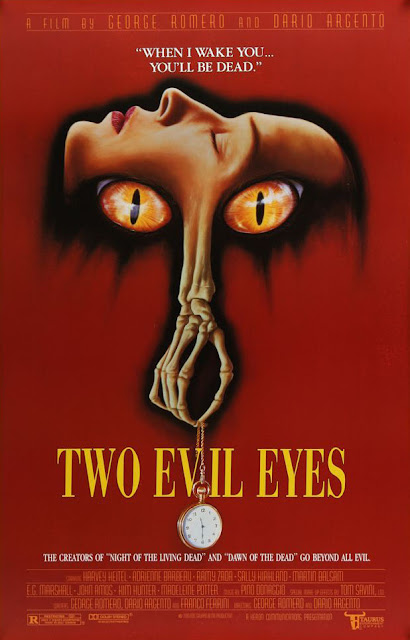Two Evil Eyes (1990) ***
Two Evil Eyes (1990) presents two legendary directors each directing half of a film based on stories by legendary author Edgar Allan Poe. The result is a mixed bag but not without merit.
The Facts In The Case Of Mr. Valdemar
George A. Romero directs the first segment, which plays as a sort of dark version of a Dynasty (1981–1989) episode. Adrienne Barbeau strikes a nice balance of rich bitch who still has an empathic side. Ramy Zada plays a soulless greedy bastard very well, Bingo O'Malley is ghoulishly good and E.G. Marshall and Tom Atkins pop up too (which makes for a neat little Creepshow (1982) semi-reunion). This one is a bit of a slow burner but has a great payoff.
The Black Cat
For Dario Argento's segment he adapts one of Poe's most well-known and frequently adapted short stories. As far as adaptations of this story by Italian directors go, I'd say Argento's version has a slight edge over Lucio Fulci's The Black Cat (1981) (my review here) for sheer spectacle, but I still prefer Sergio Martino's Your Vice Is A Locked Room And Only I Have The Key (1972) (my review here) best (though all three are fairly loose adaptations). Harvey Keitel does his usual unhinged thing well here, but, like a lot of Argento's work, the character development is thin. Visually though, it is the more dynamic of the two segments, and the stronger one overall.
In both stories Tom Savini's gruesome f/x are uniformly excellent. In Argento's they are particularly disturbing and outlandish. Pino Donaggio's score is better in the Romero segment and more electronic in the Argento segment—though there is a memorable theme in that second half that bears some similarities to Kieth Emerson and Claudio Simonetti, both of whom have also collaborated with Argento.
One would think that the pedigree of both the directors involved and the author being adapted would have culminated in some sort of horror masterpiece, but Two Evil Eyes is unfortunately not that. It is, however, a well-made and entertaining slice of cinema that contains a certain level of historical significance. I've seen the film a number of times and never been especially enamored with it, particularly in the context of the two directors' bodies of work, but it's one that I can't help but revisit.
You can find my George A. Romero Feature Films Ranked list here.
The Facts In The Case Of Mr. Valdemar
George A. Romero directs the first segment, which plays as a sort of dark version of a Dynasty (1981–1989) episode. Adrienne Barbeau strikes a nice balance of rich bitch who still has an empathic side. Ramy Zada plays a soulless greedy bastard very well, Bingo O'Malley is ghoulishly good and E.G. Marshall and Tom Atkins pop up too (which makes for a neat little Creepshow (1982) semi-reunion). This one is a bit of a slow burner but has a great payoff.
The Black Cat
For Dario Argento's segment he adapts one of Poe's most well-known and frequently adapted short stories. As far as adaptations of this story by Italian directors go, I'd say Argento's version has a slight edge over Lucio Fulci's The Black Cat (1981) (my review here) for sheer spectacle, but I still prefer Sergio Martino's Your Vice Is A Locked Room And Only I Have The Key (1972) (my review here) best (though all three are fairly loose adaptations). Harvey Keitel does his usual unhinged thing well here, but, like a lot of Argento's work, the character development is thin. Visually though, it is the more dynamic of the two segments, and the stronger one overall.
In both stories Tom Savini's gruesome f/x are uniformly excellent. In Argento's they are particularly disturbing and outlandish. Pino Donaggio's score is better in the Romero segment and more electronic in the Argento segment—though there is a memorable theme in that second half that bears some similarities to Kieth Emerson and Claudio Simonetti, both of whom have also collaborated with Argento.
One would think that the pedigree of both the directors involved and the author being adapted would have culminated in some sort of horror masterpiece, but Two Evil Eyes is unfortunately not that. It is, however, a well-made and entertaining slice of cinema that contains a certain level of historical significance. I've seen the film a number of times and never been especially enamored with it, particularly in the context of the two directors' bodies of work, but it's one that I can't help but revisit.
You can find my George A. Romero Feature Films Ranked list here.


Comments
Post a Comment